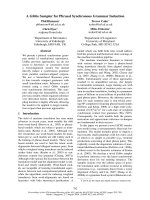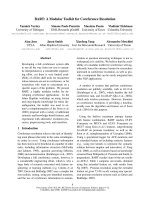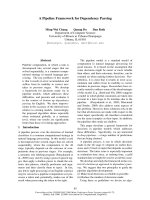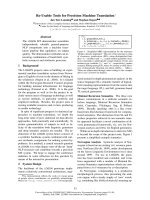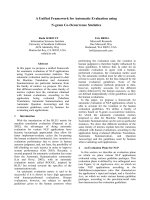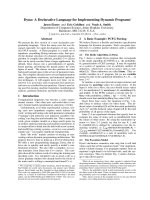Báo cáo khoa học: "A Cloud-Based Platform for Do-It-Yourself Machine Translation" potx
Bạn đang xem bản rút gọn của tài liệu. Xem và tải ngay bản đầy đủ của tài liệu tại đây (316.07 KB, 6 trang )
Proceedings of the 50th Annual Meeting of the Association for Computational Linguistics, pages 43–48,
Jeju, Republic of Korea, 8-14 July 2012.
c
2012 Association for Computational Linguistics
LetsMT!: A Cloud-Based Platform for Do-It-Yourself
Machine Translation
Andrejs Vasiļjevs Raivis Skadiņš Jörg Tiedemann
TILDE TILDE Uppsala University
Vienbas gatve 75a, Riga Vienbas gatve 75a, Riga Box 635, Uppsala
LV-1004, LATVIA
LV-1004, LATVIA SE-75126, SWEDEN
raivis.skadins@
tilde.lv
jorg.tiedemann@
lingfil.uu.se
Abstract
To facilitate the creation and usage of custom
SMT systems we have created a cloud-based
platform for do-it-yourself MT. The platform is
developed in the EU collaboration project
LetsMT!. This system demonstration paper
presents the motivation in developing the
LetsMT! platform, its main features,
architecture, and an evaluation in a practical use
case.
1 Introduction
Current mass-market and online MT systems are of
a general nature and perform poorly for smaller
languages and domain specific texts. The
European Union ICT-PSP Programme project
LetsMT! develops a user-driven MT “factory in
the cloud” enabling web users to get customised
MT that better fits their needs. Harnessing the huge
potential of the web together with open statistical
machine translation (SMT) technologies, LetsMT!
has created an online collaborative platform for
data sharing and MT building.
The goal of the LetsMT! project is to facilitate
the use of open source SMT tools and to involve
users in the collection of training data. The
LetsMT! project extends the use of existing state-
of-the-art SMT methods by providing them as
cloud-based services. An easy-to-use web interface
empowers users to participate in data collection
and MT customisation to increase the quality,
domain coverage, and usage of MT.
The LetsMT! project partners are companies
TILDE (coordinator), Moravia, and SemLab, and
the Universities of Edinburgh, Zagreb,
Copenhagen, and Uppsala.
2 LetsMT! Key Features
The LetsMT! platform
1
(Vasiļjevs et al., 2011)
gathers public and user-provided MT training data
and enables generation of multiple MT systems by
combining and prioritising this data. Users can
upload their parallel corpora to an online
repository and generate user-tailored SMT systems
based on data selected by the user.
Authenticated users with appropriate
permissions can also store private corpora that can
be seen and used only by this user (or a designated
user group). All data uploaded into the LetsMT!
repository is kept in internal format, and only its
metadata is provided to the user. Data cannot be
downloaded or accessed for reading by any means.
The uploaded data can only be used for SMT
training. In such a way, we encourage institutions
and individuals to contribute their data to be
publicly used for SMT training, even if they are
not willing to share the content of the data.
A user creates SMT system definition by
specifying a few basic parameters like system
name, source/target languages, domain, and
choosing corpora (parallel for translation models or
monolingual for language models) to use for the
particular system. Tuning and evaluation data can
be automatically extracted from the training
corpora or specified by the user. The access level
of the system can also be specified - whether it will
be public or accessible only to the particular user
or user group.
1
43
When the system is specified, the user can begin
training it. Progress of the training can be
monitored on the dynamic training chart (
Figure 1).
It provides a detailed visualisation of the training
process showing (i) steps queued for execution of a
particular training task, (ii) current execution status
of active training steps, and (iii) steps where any
errors have occurred. The training chart remains
available after the training to facilitate analysis of
the performed trainings. The last step of the
training task is automatic evaluation using BLEU,
NIST, TER, and METEOR scores.
A successfully trained SMT system can be
started and used for translation in several ways:
on the translation webpage of LetsMT! for
testing and short translations;
using LetsMT! plug-ins in computer-
assisted translation (CAT) tools for
professional translation;
integrating the LetsMT! widget for web-
site translation;
using LetsMT! plug-ins for IE and FireFox
to integrate translation into the browsers;
using LetsMT! API for MT integration into
different applications.
LetsMT! allows for several system instances to
run simultaneously to speed up translation and
balance the workload from numerous translation
requests.
LetsMT! user authentication and authorisation
mechanisms control access rights to private
training data, trained models
and SMT systems, per-
missions to initiate and
manage training tasks, run
trained systems, and access
LetsMT! services through
external APIs.
The LetsMT! platform is
populated with initial SMT
training data collected and
prepared by the project
partners. It currently contains
more than 730 million
parallel sentences in almost
50 languages. In the first 4
months since launching the
invitation only beta version
of the platform, 82 SMT
systems have been
successfully trained.
3 SMT Training and Decoding Facilities
The SMT training and decoding facilities of
LetsMT! are based on the open source toolkit
Moses. One of the important achievements of the
project is the adaptation of the Moses toolkit to fit
into the rapid training, updating, and interactive
access environment of the LetsMT! platform.
The Moses SMT toolkit (Koehn et al., 2007)
provides a complete statistical translation system
distributed under the LGPL license. Moses
includes all of the components needed to pre-
process data and to train language and translation
models. Moses is widely used in the research
community and has also reached the commercial
sector. While the use of the software is not closely
monitored, Moses is known to be in commercial
use by companies such as Systran (Dugast et al.,
2009), Asia Online, Autodesk (Plitt and Masselot,
2010), Matrixware
2
, Adobe, Pangeanic, Logrus
3
,
and Applied Language Solutions (Way et al.,
2011).
The SMT training pipeline implemented in
Moses involves a number of steps that each require
a separate program to run. In the framework of
2
Machine Translation at Matrixware:
downloads/mxw_factsheet_smt_200910.pdf
3
TDA Members doing business with Moses:
/>moses-open-source-translation/
Figure 1. Training chart providing dynamic representation of training steps.
44
LetsMT!, this process is streamlined and made
automatically configurable given a set of user-
specified variables (training corpora, language
model data, tuning sets). SMT training is
automated using the Moses experiment mana-
gement system (Koehn, 2010). Other impro-
vements of Moses, implemented by the University
of Edinburgh as part of LetsMT! project, are:
the incremental training of SMT models
(Levenberg et al., 2010);
randomised language models (Levenberg
et al., 2009);
a server mode version of the Moses
decoder and multithreaded decoding;
multiple translation models;
distributed language models (Brants et al.,
2007).
Many improvements in the Moses experiment
management system were implemented to speed up
SMT system training and to use the full potential
of the HPC cluster. We revised and improved
Moses training routines (i) by finding tasks that are
executed sequentially but can be executed in
parallel and (ii) by splitting big training tasks into
smaller ones and executing them in parallel.
4 Multitier Architecture
The LetsMT! system has a multitier architecture
(Figure 2). It has (i) an interface layer implemen-
ting the user interface and APIs with external
systems, (ii) an application logic layer for the
system logic, (iii) a data storage layer consisting of
file and database storage, and (iv) a high
performance computing (HPC) cluster. The
LetsMT! system performs various time and
resource consuming tasks; these tasks are defined
by the application logic and data storage and are
sent to the HPC cluster for execution.
The Interface layer provides interfaces between
the LetsMT! system and external users. The system
has both human and machine users. Human users
can access the system through web browsers by
using the LetsMT! web page interface. External
systems such as Computer Aided Translation
(CAT) tools and web browser plug-ins can access
the LetsMT! system through a public API. The
public API is available through both REST/JSON
and SOAP protocol web services. An HTTPS
protocol is used to ensure secure user
authentication and secure data transfer.
The application logic layer contains a set of
modules responsible for the main functionality and
logic of the system. It receives queries and
commands from the interface layer and prepares
answers or performs tasks using data storage and
the HPC cluster. This layer contains several
modules such as the Resource Repository Adapter,
the User Manager, the SMT Training Manager, etc.
The interface layer accesses the application logic
layer through the REST/JSON and SOAP protocol
web services. The same protocols are used for
communication between modules in the
application logic layer.
Figure 2. The LetsMT! system architecture
The data is stored in one central Resource
Repository (RR). As training data may change (for
example, grow), the RR is based on a version-
controlled file system (currently we use SVN as
the backend system). A key-value store is used to
keep metadata and statistics about training data and
trained SMT systems. Modules from the
application logic layer and HPC cluster access RR
through a REST-based web service interface.
A High Performance Computing Cluster is used
to execute many different computationally heavy
data processing tasks – SMT training and running,
corpora processing and converting, etc. Modules
from the application logic and data storage layers
45
create jobs and send them to the HPC cluster for
execution. The HPC cluster is responsible for
accepting, scheduling, dispatching, and managing
remote and distributed execution of large numbers
of standalone, parallel, or interactive jobs. It also
manages and schedules the allocation of distributed
resources such as processors, memory, and disk
space. The LetsMT! HPC cluster is based on the
Oracle Grid Engine (SGE).
The hardware infrastructure of the LetsMT!
platform is heterogeneous. The majority of
services run on Linux platforms (Moses, RR, data
processing tools, etc.). The Web server and
application logic services run on a Microsoft
Windows platform.
The system hardware architecture is designed to
be highly scalable. The LetsMT! platform contains
several machines with both continuous and on-
demand availability:
Continuous availability machines are used
to run the core frontend and backend
services and the HPC grid master to
guarantee stable system functioning;
On-demand availability machines are used
(i) to scale up the system by adding more
computing power to training, translation,
and data import services (HPC cluster
nodes) and (ii) to increase performance of
frontend and backend server instances.
To ensure scalability of the system, the whole
LetsMT! system including the HPC cluster is
hosted by Amazon Web Services infrastructure,
which provides easy access to on-demand
computing and storage resources.
5 Data Storage and Processing Facilities
As a data sharing and MT platform, the LetsMT!
system has to store and process large amounts of
SMT training data (parallel and monolingual
corpora) as well as trained models of SMT
systems. The Resource Repository (RR) software
is fully integrated into the LetsMT! Platform and
provides the following major components:
Scalable data storage based on version-
controlled file systems;
A flexible key-value store for metadata;
Access-control mechanisms defining three
levels of permission (private data, public
data, shared data);
Data import modules that include tools for
data validation, conversion and automatic
sentence alignment for a variety of popular
document formats.
The general architecture of the Resource
Repository is illustrated in Figure 3. It is
implemented in terms of a modular package that
can easily be installed in a distributed environment.
RR services are provided via Web API’s and
secure HTTP requests. Data storage can be
distributed over several servers as is illustrated in
Figure 3. Storage servers communicate with the
central database server that manages all metadata
records attached to resources in the RR. Data
resources are organised in slots that correspond to
file systems with user-specific branches. Currently,
the RR package implements two storage backends:
a plain file system and a version-controlled file
system based on subversion (SVN). The latter is
the default mode, which has several advantages
over non-revisioned data storage. Revision control
systems are designed to handle dynamically
growing collections of mainly textual data in a
multi-user environment. Furthermore, they keep
track of modifications and file histories to make it
possible to backtrack to prior revisions. This can
be a strong advantage, especially in cases of shared
data access. Another interesting feature is the
possibility to create cheap copies of entire
branches that can be used to enable data
modifications by other users without
compromising data integrity for others. Finally,
SVN also naturally stores data in a compressed
format, which is useful for large-scale document
collections. In general, the RR implementation is
modular, other storage backends may be added
later, and each individual slot can use its own
backend type.
Another important feature of the RR is the
support of a flexible database for metadata. We
decided to integrate a modern key-value store into
the platform in order to allow a maximum of
flexibility. In contrast to traditional relational
databases, key-value stores allow the storage of
arbitrary data sets based on pairs of keys and
values without being restricted to a pre-defined
schema or a fixed data model. Our implementation
relies on TokyoCabinet
4
, a modern implementation
of schema-less databases that supports all of our
4
https://fallabs/tokyocabinet
46
requirements in terms of flexibility and efficiency.
In particular, we use the table mode of
TokyoCabinet that supports storage of arbitrary
data records connected to a single key in the
database. We use resource URL’s in our repository
to define unique keys in the database, and data
records attached to these keys may include any
number of key-value pairs. In this way, we can add
any kind of information to each addressable
resource in the RR. The software also supports
keys with unordered lists of values, which is useful
for metadata such as languages (in a data
collection) and for many other purposes.
Moreover, TokyoCabinet provides powerful query
language and software bindings for the most
common programming languages. It can be run in
client-server mode, which ensures robustness in a
multi-user environment and natively supports data
replication. Using TokyoCabinet as our backend,
we implemented a key-value store for metadata in
the RR that can easily be extended and queried
from the frontend of the LetsMT! Platform via
dedicated web-service calls.
Yet another important feature of the RR is the
collection of import modules that take care of
validation and conversion of user-provided SMT
training material. Our main goal was to make the
creation of appropriate data resources as painless
as possible. Therefore, we included support for the
most common data formats to be imported into
LetsMT!. Pre-aligned parallel data can be uploaded
in TMX, XLIFF, and Moses formats. Monolingual
data can be provided in plain text, PDF, and MS
Word formats. We also support the upload of
compressed archives in zip and tar format. In the
future, other formats
can easily be
integrated in our
modular implemen-
tation.
Validation of such
a variety of formats is
important. Therefore
among others, we
included XML/DTD
validation, text en-
coding detection soft-
ware, and language
identification tools
with pre-trained mo-
dels for over 60 lan-
guages.
Furthermore, our system also includes tools for
automatic sentence alignment. Import processes
automatically align translated documents with each
other using standard length-based sentence
alignment methods (Gale and Church, 1993; Varga
et al., 2005).
Finally, we also integrated a general batch-
queuing system (SGE) to run off-line processes
such as import jobs. In this way, we further
increase the scalability of the system by taking the
load off repository servers. Data uploads
automatically trigger appropriate import jobs that
will be queued on the grid engine using a dedicated
job web-service API.
6 Evaluation for Usage in Localisation
One of the usage scenarios particularly targeted by
the project is application in the localisation and
translation industry. Localisation companies
usually have collected significant amounts of
parallel data in the form of translation memories.
They are interested in using this data to create
customised MT engines that can increase
productivity of translators. Productivity is usually
measured as an average number of words
translated per hour. For this use case, LetsMT! has
developed plug-ins for integration into CAT tools.
In addition to translation candidates from
translation memories, translators receive
translation suggestions provided by the selected
MT engine running on LetsMT!.
As part of the system evaluation, project partner
Moravia used the LetsMT! platform to train and
Figure 3. Resource repository overview
47
evaluate SMT systems for Polish and Czech. An
English-Czech engine was trained on 0.9M parallel
sentences coming from Moravia translation
memories in the IT and tech domain part of the
Czech National Corpus. The resulting system
increased translator productivity by 25.1%. An
English-Polish system was trained on 1.5M
parallel sentences from Moravia production data in
the IT domain. Using this system, translator
productivity increased by 28.5%.
For evaluation of English-Latvian translation,
TILDE created a MT system using a significantly
larger corpus of 5.37M parallel sentence pairs,
including 1.29M pairs in the IT domain.
Additional tweaking was made by manually
adding a factored model over disambiguated
morphological tags. The resulting system
increased translator productivity by 32.9%
(Skadiņš et al., 2011).
7 Conclusions
The results described in this paper show that the
LetsMT! project is on track to fulfill its goal to
democratise the creation and usage of custom SMT
systems. LetsMT! demonstrates that the open
source SMT toolkit Moses is reaching maturity to
serve as a base for large scale and heavy use
production purposes. The architecture of the
platform and Resource Repository enables
scalability of the system and very large amounts of
data to be handled in a variety of formats.
Evaluation shows a strong increase in translation
productivity by using LetsMT! systems in IT
localisation.
Acknowledgments
The research within the LetsMT! project has
received funding from the ICT Policy Support
Programme (ICT PSP), Theme 5 – Multilingual
web, grant agreement 250456.
References
L. Dugast, J. Senellart, P. Koehn. 2009. Selective
addition of corpus-extracted phrasal lexical rules to a
rule-based machine translation system. Proceedings
of MT Summit XII.
T. Brants, A.C. Popat, P. Xu, F.J Och, J. Dean. 2007.
Large Language Models in Machine Translation.
Proceedings of the 2007 Joint Conference on
Empirical Methods in Natural Language Processing
and Computational Natural Language Learning
(EMNLP-CoNLL), 858-867. Prague, Czech Republic
W. A. Gale, K. W. Church. 1993. A Program for
Aligning Sentences in Bilingual Corpora.
Computational Linguistics 19 (1): 75–102
P. Koehn, M. Federico, B. Cowan, R. Zens, C. Duer, O.
Bojar, A. Constantin, E. Herbst. 2007. Moses: Open
Source Toolkit for Statistical Machine Translation.
Proceedings of the ACL 2007 Demo and Poster
Sessions, 177-180. Prague.
P. Koehn. 2010. An experimental management system.
The Prague Bulletin of Mathematical Linguistics, 94.
A. Levenberg, M. Osborne. 2009. Stream-based Ran-
domised Language Models for SMT. Proceedings of
the 2009 Conference on Empirical Methods in
Natural Language Processing.
A. Levenberg, C. Callison-Burch, M. Osborne. 2010.
Stream-based Translation Models for Statistical
Machine Translation. Human Language
Technologies: The 2010 Annual Conference of the
North American Chapter of the Association for
Computational Linguistics (HLT '10)
M. Plitt, F. Masselot. 2010. A Productivity Test of
Statistical Machine Translation Post-Editing in a
Typical Localisation Context. The Prague Bulletin of
Mathematical Linguistics, 93(January 2010): –16
R. Skadiņš, M. Puriņš, I. Skadiņa, A. Vasiļjevs. 2011.
Evaluation of SMT in localization to under-resourced
inflected language. Proceedings of the 15th
International Conference of the European
Association for Machine Translation EAMT 2011,
35-40. Leuven, Belgium
A. Vasiļjevs, R. Skadiņš, I. Skadiņa. 2011. Towards
Application of User-Tailored Machine Translation in
Localization. Proceedings of the Third Joint
EM+/CNGL Workshop “Bringing MT to the User:
Research Meets Translators” JEC 2011, 23-31.
Luxembourg
D. Varga, L. Németh, P. Halácsy, A. Kornai, V. Trón,
V. Nagy. 2005. Parallel corpora for medium density
languages. Recent Advances in Natural Language
Processing IV Selected papers from RANLP05, 590-
596
A. Way, K. Holden, L. Ball, G. Wheeldon. 2011.
SmartMATE: online self-serve access to state-of-the-
art SMT. Proceedings of the Third Joint EM+/CNGL
Workshop “Bringing MT to the User: Research
Meets Translators” (JEC ’11), 43-52. Luxembourg
48



